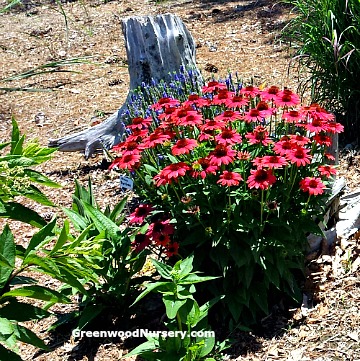Free gardening gloves when you spend $75.00 or more!
Pollination gardens attract many types of native bees and non-bee insects -
Government agencies, botanical gardens, universities, municipalities, home gardeners and even welcome centers are creating pollinator gardens with bee friendly plants to attract native types of bees and other non-bee pollinators like butterflies, moths, beetles, flies, ants, birds and bats.
With over 4000 native types of bees species in the United States alone, there are many opportunities to attract pollinating insects to your pollinator garden. Plant a variety of native and luring plants around your vegetable, kitchen herbs to entice in these insects. Attract safe native bees like the mason bees and carpenter bees with native bee friendly plants.
The honey bee is relatively new to the United States as it was brought over from Europe by European settlers. Also, they don't pollinate native food crops like cherries, blueberries, tomatoes, melons or eggplants to name just a few.

7 Tips for a pollinator garden
- Include a wide selection of native flowering plants - include trees, shrubs, perennials, wildflowers that will bloom in succession from late winter or early spring on to late fall. Native plant varieties produce nectar and pollen that attracts pollinating insects, require less care and, in many cases, are hardier than improved cultivar of the same plant. Click here for our selection of pollinator garden plants which includes plants bees love.
- Reduce the size of your lawn with pollinator plants or include some within lawn areas that are not mowed allowing them to flower. Plant clover or wildflower seeds into the lawn area where it can grow, flower and attract native bees.
- Avoid pesticides and other chemicals. If it is necessary to use a pesticide or chemicals, consider when possible selecting organic products. Apply in late evening into early morning when pollinators are generally not active. Avoid getting any of the chemicals on open flowers and buds. Most chemicals and foliar pesticides wash away after a few days.
- Provide a water source. A bowl, mud puddle or bird bath of clean water are choice water sources for pollinators. During sunny warm weather, water will quickly evaporate and may need replaced every 2 or 3 days. Check the source frequently to keep clean and fresh. Mix a small amount of wood ashes or sea salt into the mud to create a 'salt lick' for birds and insects.
- Provide nesting or resting areas. Bare soil areas in the lawn or garden, sand piles, old tree stumps, posts, and logs make excellent nesting habitats for pollinators. Drill holes into the wood (approximately 3/8" by 4 inches deep). Logs can be turned into planters for double use.
- Add bee nests and bee boxes. Watching bees can be quite entertaining and an interesting (and safe) way to observe wildlife. Creating a bee nest doesn't need to be a costly or time consuming project. It's as simple as bundling paper (not plastic!) straws, tying them securely together and placing in a box or other container to secure the back opened area. Bee boxes or bee hotels can be built with items found around the property or house and assembled. This excellent article on Bee box Hotels shows just that on how to 'assemble a bee house'.
- Offer overripe fruits and vegetables. When fruits and vegetables are past their best use period and you're ready to toss them out, place them in the pollinator garden. Slice or break large pieces down into smaller ones and sprinkle with sea salt.
Click here to begin selecting your pollinator garden plants.
Easy to make videos on a building bee house and bug hotels
- cheryl's blog
- Log in or register to post comments








Comments
Yes - they are designed to